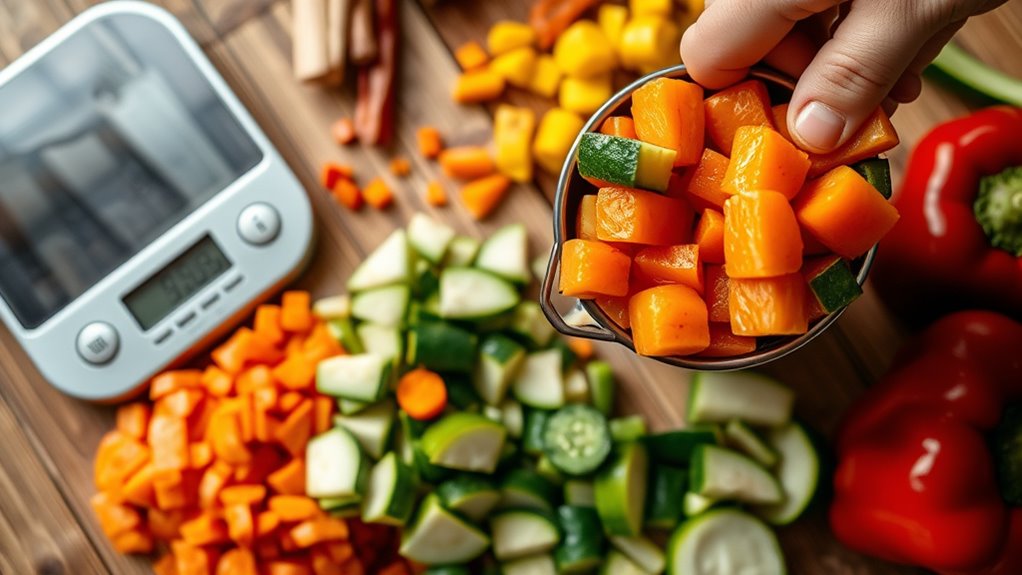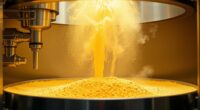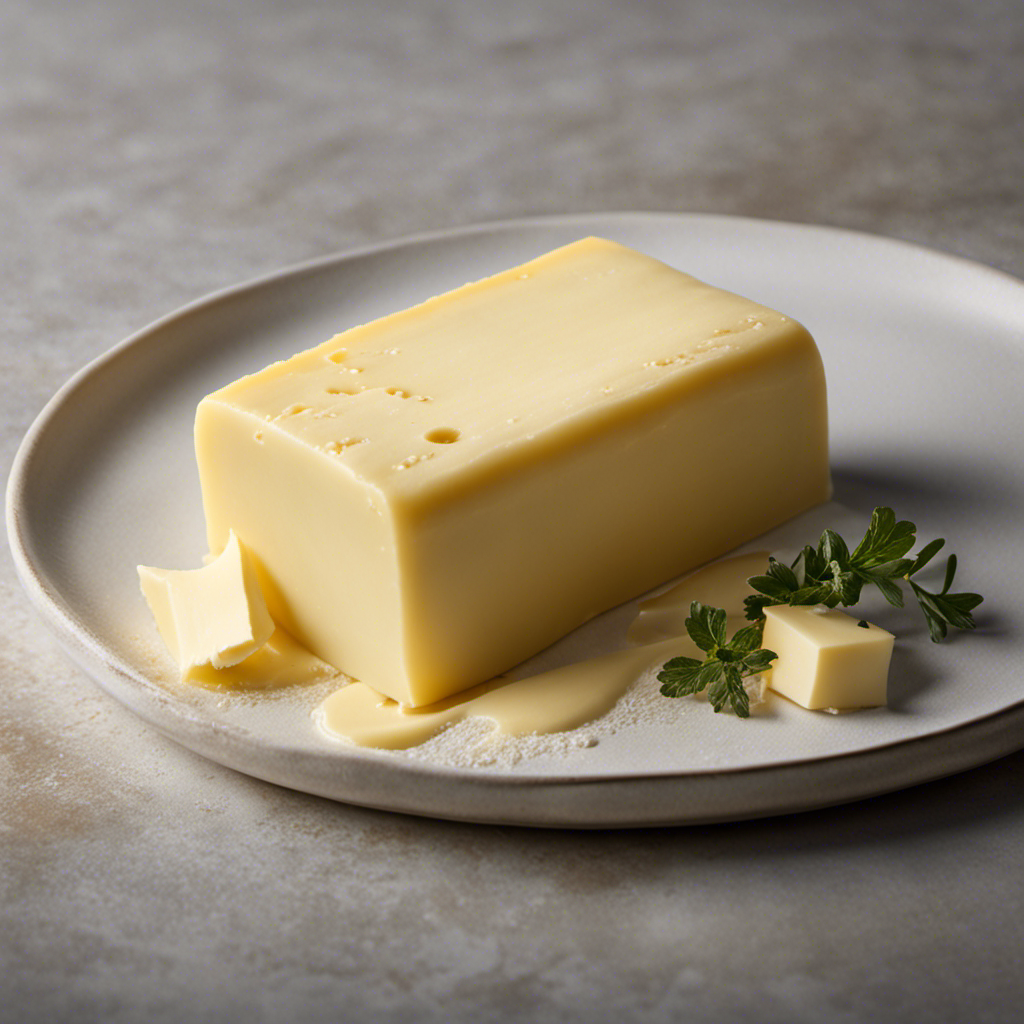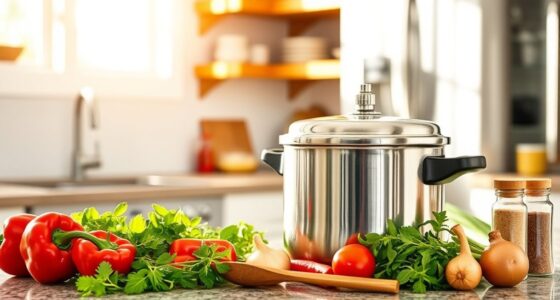To measure vegetables for roasting properly, start by choosing fresh, uniform pieces for even cooking, and use precise tools like measuring cups, spoons, or a digital scale to guarantee consistent portions. Cut vegetables into sizes suited for their texture—chunky, thick slices, or thin slices—based on desired results. Keep an eye on cooking times that vary with size and type, and monitor during roasting to perfect timing and doneness. Continue exploring for more tips to get flawless roasted vegetables.
Key Takeaways
- Use a digital kitchen scale to weigh chopped vegetables for precise portioning and consistent roasting results.
- Measure oil, seasonings, and marinades with measuring spoons or cups to ensure balanced flavor.
- Uniformly cut vegetables into similar sizes to promote even cooking and accurate timing.
- Use measuring cups for liquids like oils or broth to control moisture and prevent over-saturation.
- Record measurements for repeated recipes to maintain consistency across different batches.
Selecting the Correct Vegetables and Quantities
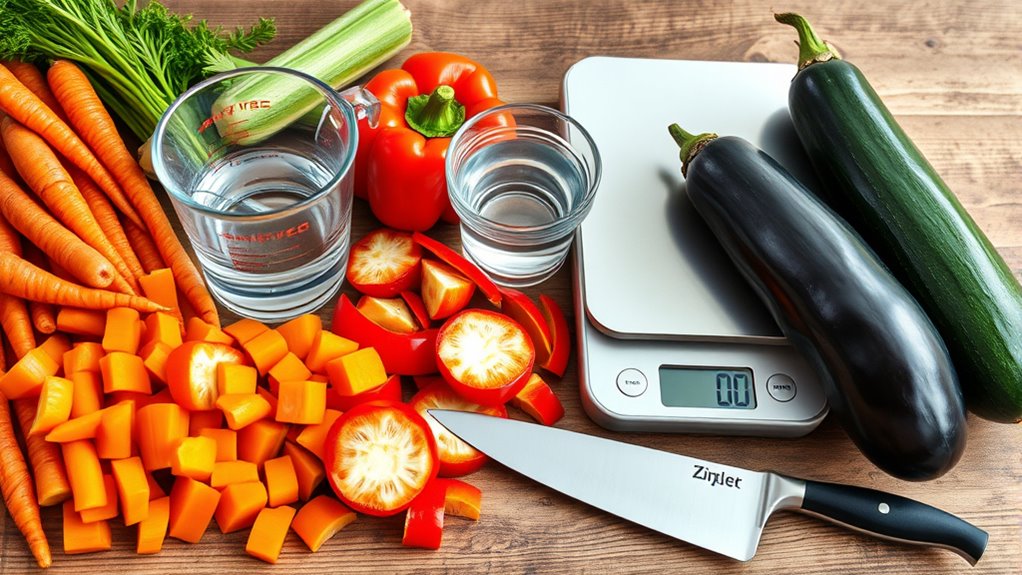
Choosing the right vegetables and quantities is essential for a successful roasting session. Start by selecting vegetables with high vegetable freshness; fresh produce ensures vibrant flavor and better texture. Think about a variety of root vegetables, squash, or sturdy greens that hold up well to roasting. Pay attention to seasoning balance—using a mix of sweet, earthy, and savory vegetables helps create a harmonious dish. Measure your vegetables carefully to avoid overcrowding, which can lead to uneven cooking. Properly portioning ensures each piece roasts evenly and develops a delicious caramelized exterior. Remember, the goal is to have enough vegetables to fill your roasting pan without overcrowding, maintaining proper air circulation. This approach guarantees ideal flavor, texture, and seasoning throughout your roasted vegetables. Additionally, understanding the importance of vegetable freshness can significantly impact the outcome of your dish.
Preparing Vegetables for Even Roasting
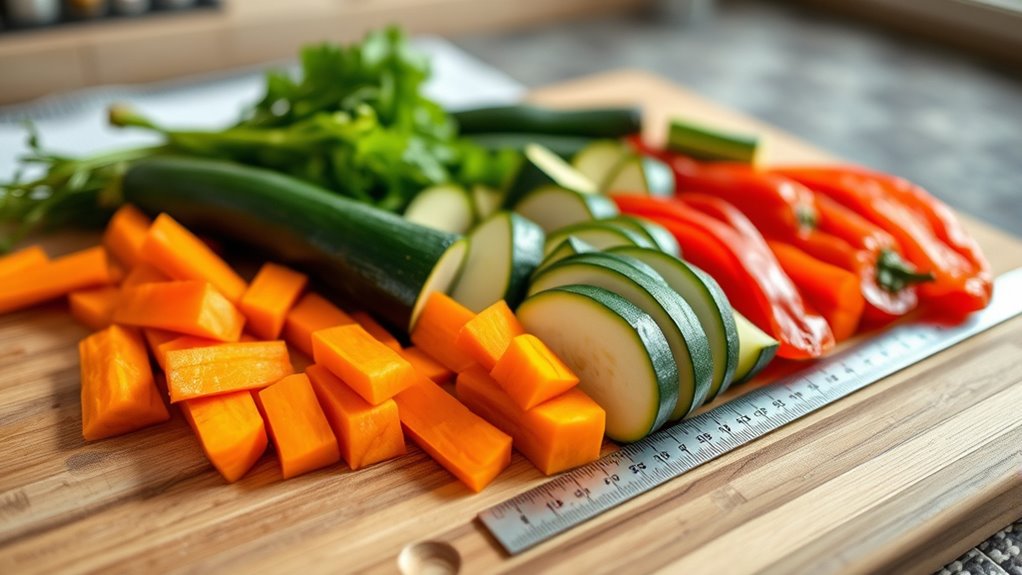
Once you’ve selected the right vegetables and measured out appropriate quantities, the next step is to prepare them for roasting. Proper vegetable storage before cooking helps maintain freshness and flavor, so keep your vegetables refrigerated until you’re ready to prep. When preparing, wash and thoroughly dry them to ensure even browning. Cut the vegetables into uniform sizes to promote consistent cooking; this step is essential for even roasting. Removing excess moisture and ensuring even sizing also enhances flavor, as it allows seasonings and oils to penetrate better. Additionally, preheating your oven ensures the vegetables start roasting immediately, locking in their natural flavors. Being aware of juice extraction techniques can also help in preparing vegetables with higher moisture content for roasting. By preparing your vegetables carefully, you set the stage for a perfectly roasted, flavorful dish.
Choosing the Right Cutting Techniques and Sizes
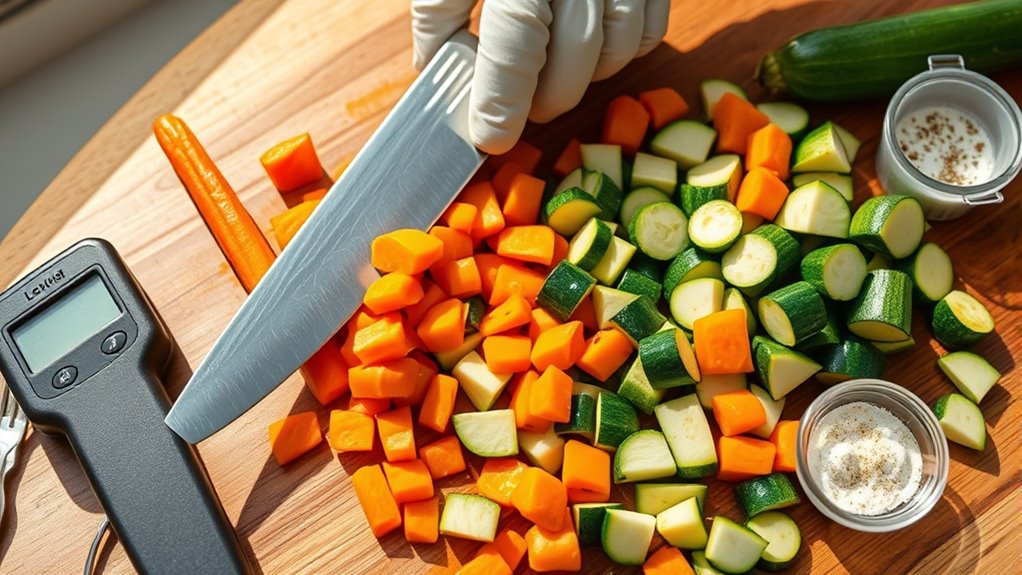
Using uniform sizes guarantees your vegetables cook evenly, so choose your cuts accordingly. The right technique depends on the vegetable and your desired texture—whether you want chunky pieces or thin slices. Consider how the size affects roasting time to get perfect results every time. Additionally, understanding cultural narratives can inspire creative presentation and flavor pairings in your roasted vegetables.
Uniform Size Matters
To guarantee your vegetables roast evenly, it’s vital to cut them into uniform sizes. Consistent pieces ensure even cooking, preventing some from being underdone while others become overdone. When working with a variety of vegetables, aim for similar sizes to promote seasoning optimization, allowing flavors to develop uniformly. For example, root vegetables like carrots and potatoes should be sliced similarly, while softer vegetables like zucchini can be cut slightly smaller. This approach helps all ingredients reach the perfect texture at the same time. Keep in mind that different vegetable varieties have different cooking times, so adjusting sizes accordingly ensures each vegetable roasts properly without over or undercooking. Proper maintenance of your roasting equipment also plays a crucial role in achieving consistent results. Uniform sizing is key to achieving a balanced, flavorful roasted vegetable medley.
Optimal Cutting Techniques
Choosing the right cutting techniques is essential for achieving evenly roasted vegetables. Properly cutting ensures consistent cooking and enhances flavor. First, decide on the size and shape—uniform pieces promote even seasoning application and roasting.
- Use a sharp knife to peel vegetables smoothly, removing any tough skin.
- Cut vegetables into cubes or uniform sticks to ensure even heat exposure.
- Keep sizes consistent so seasoning sticks well and cooks at the same rate.
- For softer vegetables, thinner slices work better, while firmer ones benefit from thicker cuts.
These techniques help you control vegetable peeling, optimize seasoning application, and achieve perfectly roasted results. Precision in cutting helps you control the cooking process, ensuring each piece reaches the desired texture and flavor.
Chunky vs. Thin Slices
Deciding between chunky and thin slices depends on the texture and flavor you want to achieve in your roasted vegetables. Chunky cuts tend to retain more moisture, resulting in a tender, hearty vegetable with a satisfying bite. They also provide a slower cooking process, allowing flavors to deepen and develop fully. Thin slices, on the other hand, roast faster and develop a crisp exterior, which enhances flavor through caramelization. They offer a different vegetable texture—lighter and more delicate—and are ideal when you want a quicker, more evenly roasted result. Your choice impacts flavor enhancement and overall dish texture. For heartier dishes, go chunky; for crisp, evenly roasted vegetables, opt for thin slices. Matching your cut thickness to your desired vegetable texture ensures excellent roasting results. Additionally, understanding the production quantity variance can help in planning the amount of vegetables needed, ensuring efficiency and reducing waste during meal prep.
Using the Proper Measuring Tools for Consistency
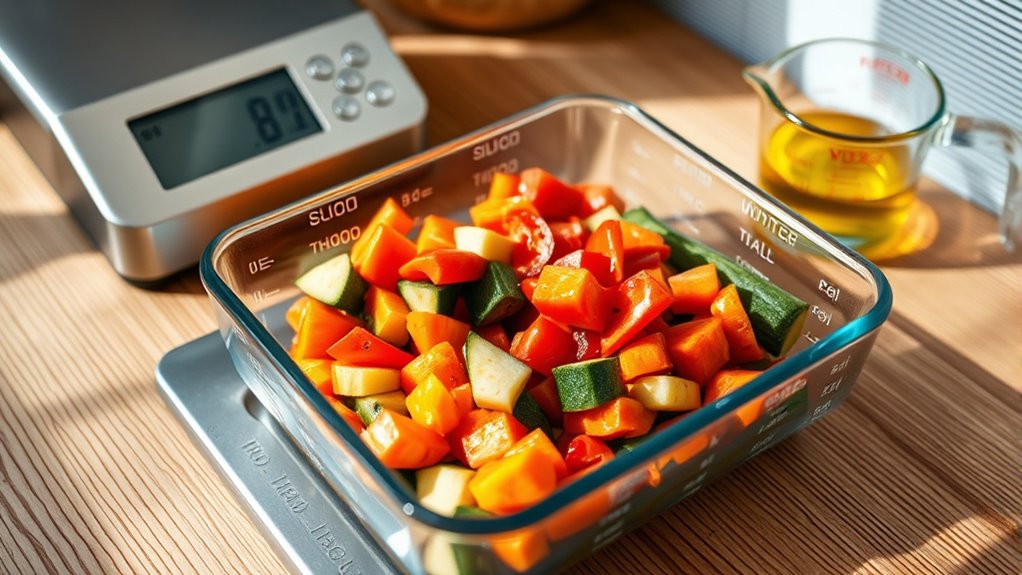
Using the right measuring tools guarantees your roasted vegetables turn out perfectly every time. You’ll want to choose tools that help you measure ingredients accurately and control portion sizes consistently. This way, your results stay reliable, and your dishes come out just right. Incorporating calibration techniques ensures your measuring tools maintain accuracy over time.
Choosing the Right Tools
To guarantee your roasted vegetables turn out consistently delicious, selecting the right measuring tools is essential. Good kitchen gadgets ensure measurement accuracy, helping you get perfect results every time. Opt for tools that suit the texture and size of your vegetables. Here are some essential tools to consider:
- Measuring cups and spoons – for precise volume measurements of oil or seasonings.
- Digital kitchen scale – for weight accuracy of chopped vegetables.
- Adjustable measuring jug – perfect for liquids or marinades.
- Calibrated spoons – for small ingredient portions, like herbs or spices.
Using these tools ensures your measurements are consistent, giving you better control over roasting times and flavors. Proper measurement techniques align with kitchen measurement practices and help achieve the desired culinary results. Prioritize quality and accuracy in your kitchen gadgets for optimal results.
Measuring Ingredients Accurately
Accurate measurement of ingredients is essential for achieving consistent roasting results, and selecting the proper tools makes this process much easier. Use dry measuring cups for vegetables and seasonings to ensure precise quantities, which helps you apply seasoning techniques evenly. For liquids like oils or marinades, opt for liquid measuring cups with clear markings. Keep storage considerations in mind; measuring tools should be clean and dry to prevent contamination or inaccuracies. Proper measurements help you avoid over-seasoning or under-seasoning, maintaining flavor balance. Additionally, measuring ingredients accurately ensures your seasoning techniques produce the desired taste every time. Using the right tools and paying attention to measurement details ultimately lead to more consistent, delicious roasted vegetables. Being aware of narcissistic traits in your cooking process can also help you maintain confidence and control over your culinary creations.
Consistent Portion Control
Achieving consistent portion control when roasting vegetables relies heavily on selecting the right measuring tools. Accurate measurements help manage seasonal variations and optimize flavor enhancements. To keep portions uniform, consider these tools:
- Measuring cups for chopped vegetables, ensuring each batch has the same amount.
- Kitchen scale for precise weight, especially when adjusting for seasonal variations in vegetable size.
- Liquid measuring cups for marinades or oils, maintaining consistent flavor enhancements.
- Scoops or portioners to quickly and evenly divide vegetables, reducing guesswork.
- Using these tools can also help in understanding portion control benefits, which contribute to better dietary habits and meal consistency.
Using these tools ensures each portion is consistent, which improves roasting results and flavor balance. Proper portion control helps you adapt to seasonal variations while maintaining the desired taste and texture every time.
Estimating Cooking Time Based on Size and Type
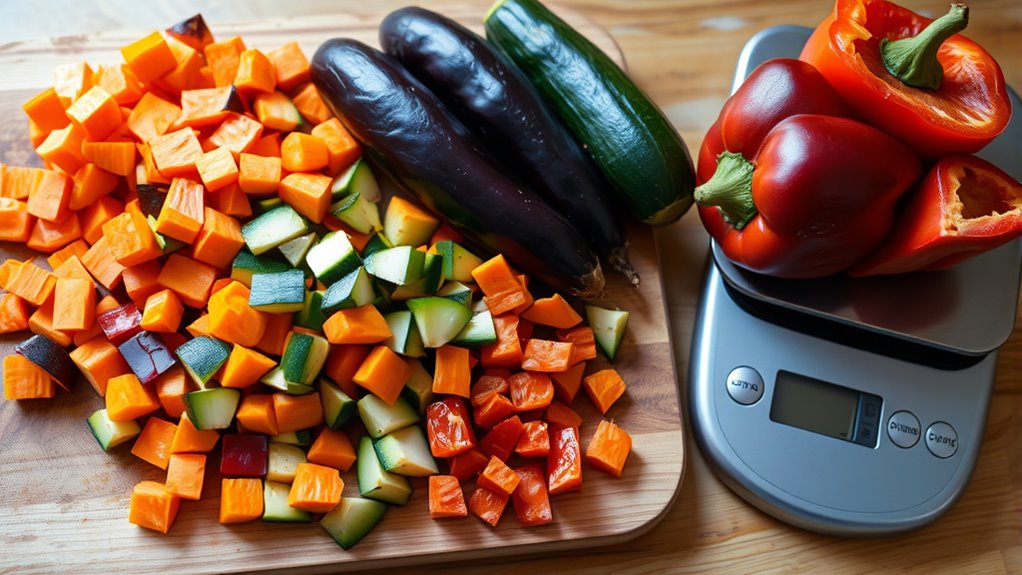
The size and type of vegetables play a crucial role in determining their roasting times. Larger veggie varieties require longer cooking durations, while smaller pieces roast faster. For example, a whole sweet potato takes more time than cubed zucchini. To estimate accurately, consider their density and water content, which influence cooking speed. Use this table as a guide:
| Veggie Variety | Typical Cooking Duration |
|---|---|
| Root vegetables | 40-50 minutes |
| Soft vegetables | 20-30 minutes |
| Firm vegetables | 30-40 minutes |
Keep in mind, denser veggies need more time, and smaller cuts can reduce roasting durations. Adjust based on the size and veggie varieties you’re working with for perfect results. Additionally, understanding the vegetable type can help you better estimate roasting times and achieve consistent results.
Monitoring Vegetables During the Roasting Process
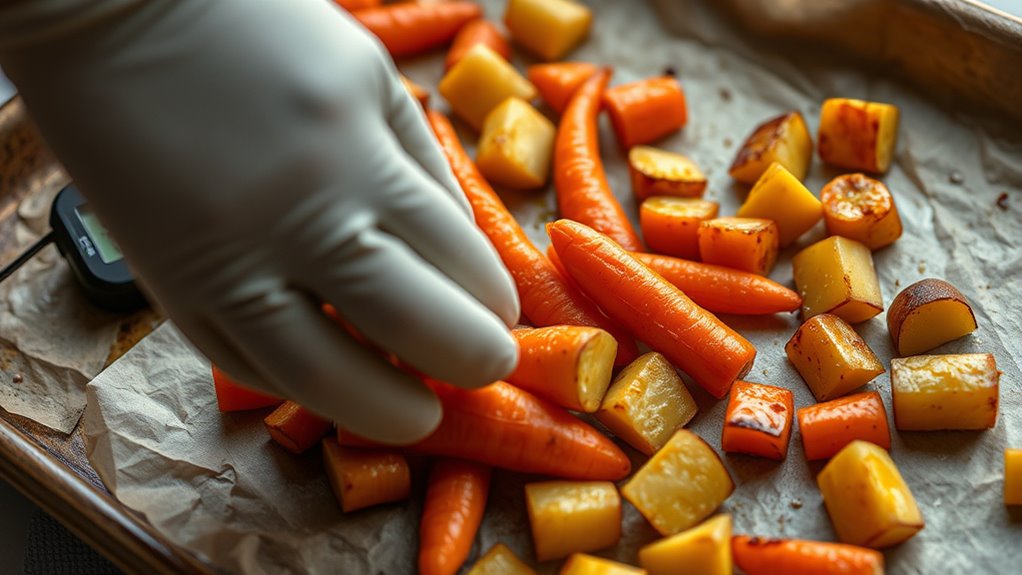
Once you’ve estimated the roasting time based on vegetable size and type, keeping an eye on them as they cook helps guarantee perfect results. Monitoring ensures you catch the right moment to remove them for maximum flavor enhancement. As you watch, look for:
- Color change—vegetables should turn golden brown, signaling doneness.
- Texture—they should feel tender when pierced with a fork.
- Moisture levels—avoid excessive dryness or greasiness.
- Even cooking—rotate or stir if necessary to prevent uneven roasting.
Regular tableware like tongs or spatulas can assist in turning or removing vegetables evenly. Proper vegetable storage before roasting preserves freshness and flavor. Regular monitoring not only helps you avoid overcooking but also ensures the vegetables stay flavorful and retain their ideal texture, making your roasted vegetables irresistible.
Adjusting Measurements for Different Oven Temperatures
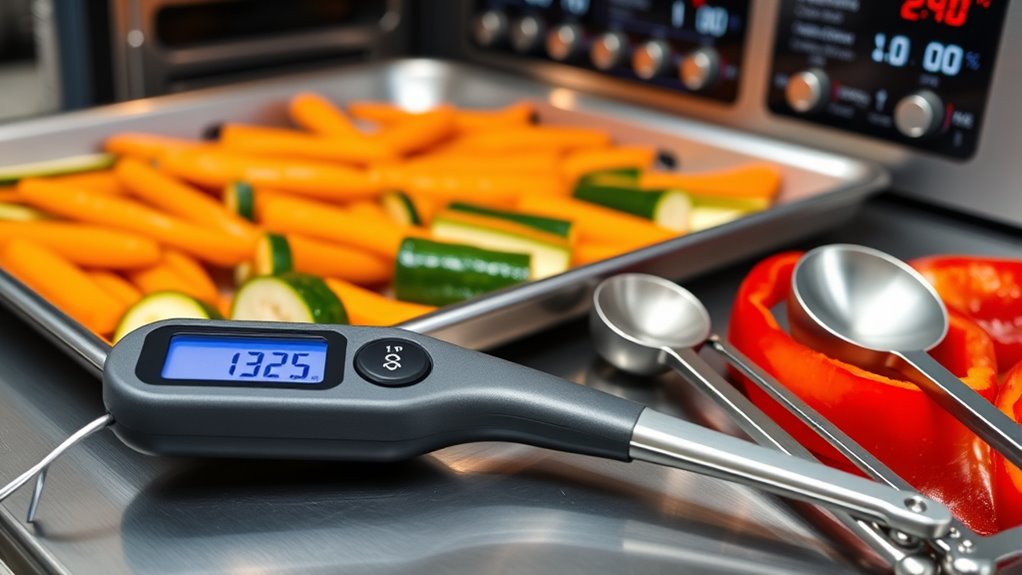
Adjusting cooking times when you change oven temperatures is essential to guarantee your vegetables roast perfectly. Variations in oven calibration can cause temperature variance, affecting roasting results. If your oven runs hot or cool, you may need to modify the cooking time accordingly. For example, lowering the temperature by 25°F might require extending the roasting time by a few minutes, while increasing it could shorten the process. To ensure accuracy, consider using an oven thermometer to check the actual temperature and account for any calibration issues. Remember, consistent oven calibration minimizes temperature variance, helping you achieve uniform roasting. Always monitor your vegetables closely when tweaking temperatures, as slight changes can impact cooking time and texture. Additionally, understanding support hours for appliances or services can help you schedule maintenance or troubleshooting visits to keep your oven in optimal condition.
Tips for Achieving Perfectly Roasted Vegetables Every Time
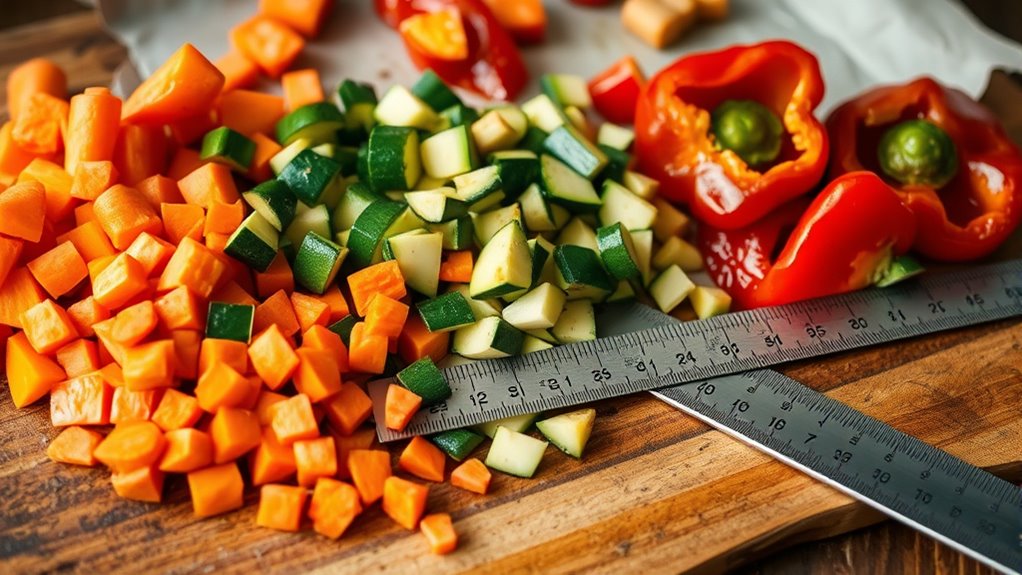
Achieving perfectly roasted vegetables every time requires attention to key techniques that bring out their best flavor and texture. First, season generously with your preferred spices or herbs to enhance flavor. Second, spread the vegetables in a single layer on the baking sheet to ensure even cooking. Third, use presentation techniques like tossing with a drizzle of oil or garnishing with fresh herbs after roasting to improve visual appeal. Fourth, monitor roasting times closely, adjusting based on vegetable type and size. Remember, seasoning preferences can vary, so taste-test before serving. For a polished look, consider arranging roasted vegetables neatly or adding a splash of balsamic glaze. Additionally, choosing the right cooking equipment can make a significant difference in achieving perfectly roasted vegetables. These tips help you consistently achieve flavorful, beautifully presented roasted vegetables.
Frequently Asked Questions
How Do I Measure Vegetables if I Don’t Have a Scale?
If you don’t have a scale, you can use visual estimation or measuring cups to measure vegetables. For example, a cup of chopped vegetables usually weighs around 150 grams. When chopping, fill your measuring cup to get an approximate amount. With practice, you’ll get better at visual estimation, so you can gauge quantities quickly without needing precise measurements. This approach works well for most roasting recipes.
Can I Use Volume Measurements Instead of Weight for Vegetables?
Like a knight wielding a quill, you can use volume measurements instead of weight for vegetables, but beware—measurement accuracy varies. Volume vs weight can lead to inconsistencies, especially with different vegetable types and cuts. For most recipes, measuring by cups or liters works, but if precision matters, weighing is more reliable. Trust your judgment and adjust as needed to achieve the best roasted vegetables.
How Do I Account for Moisture Content When Measuring Vegetables?
You should account for moisture variability by weighing your vegetables rather than relying on volume. Moisture content can change, affecting weight and measurement consistency. To get accurate results, weigh your vegetables before roasting, as this reflects their true mass regardless of moisture fluctuations. Consistently using weight ensures more reliable measurements, helping you achieve better roasting results and maintaining recipe accuracy despite moisture variations.
Are There Differences in Measurements for Fresh Versus Frozen Vegetables?
Yes, there are differences in measurements for frozen versus fresh vegetables because frozen ones often have more moisture, affecting measurement accuracy. When using frozen vegetables, you might need to account for extra water content, which can influence weight and volume. For the most accurate results, consider draining excess liquid from frozen veggies before measuring, and adjust your measurements accordingly to guarantee consistency in your roasting process.
Should I Measure Vegetables Before or After Peeling and Trimming?
You should measure vegetables before peeling and trimming to get an accurate peeling weight. Peeling and trimming can remove inconsistent amounts of weight, affecting your measurement. If you measure after, you risk underestimating the total weight, which can lead to uneven roasting. For the best consistency, measure your vegetables once they’re trimmed but before peeling, ensuring you account for trimming consistency and get precise, reliable measurements.
Conclusion
By measuring your vegetables carefully, you set the stage for a roast that’s golden and tender, each piece perfectly caramelized. Imagine the aroma filling your kitchen, the vibrant colors of roasted carrots and Brussels sprouts glistening in the oven’s warm glow. With precise measurements and attentive monitoring, you’ll create a symphony of flavors and textures that turn simple vegetables into a memorable, mouthwatering masterpiece every time.
